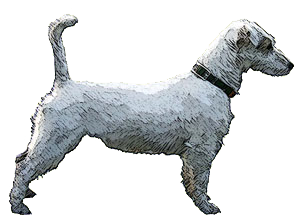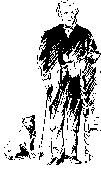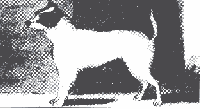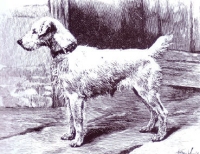
|
|

| FCI - Standard Nr.345 | |
| Origin | England |
| Country of Developmet | Australia |
| Classification F.C.I | Group 3 Terriers/Section 2 Small Terriers |
| Ideal Height | 25 to 30 cm |
| Weight | 1 kg to each 5 cm in height |
|
|
||
 The
Jack Russell Terrier is a fox hunting dog, developed in England in the
19th century. There were terriers of all descriptions hunting earth dwelling
creatures for hundreds of years before the Reverend John (Jack) Russell
developed his particular "strain" of hunting terriers. The Reverend
lived in the mid-1800's in Devonshire. He maintained his dogs with a certain
body style and temperament best suited to do the job of fox hunting. Our
present day Jack Russell Terriers came to be soley by the efforts of this
fox hunting parson. The conformation of the Jack Russell Terrier follows
it's original function. Early Britisch fox hunters used a black and tan
type terrier, rather than the Fell or Welsh Terrier, whose colouring was
too similar to the quarry it was hunting, namely, the fox. Difficulty in
telling the terrier from the creature it was bolting out of it's den brought
about the desiere for a more white-bodied dog. In all probability the Englisch
Black and Tan Terrier was crossed with the Old Englisch White Terrier (both
now extinct) to achieve the type of coat and colouring we have taday in
our Jack Russell Terriers. The
Jack Russell Terrier is a fox hunting dog, developed in England in the
19th century. There were terriers of all descriptions hunting earth dwelling
creatures for hundreds of years before the Reverend John (Jack) Russell
developed his particular "strain" of hunting terriers. The Reverend
lived in the mid-1800's in Devonshire. He maintained his dogs with a certain
body style and temperament best suited to do the job of fox hunting. Our
present day Jack Russell Terriers came to be soley by the efforts of this
fox hunting parson. The conformation of the Jack Russell Terrier follows
it's original function. Early Britisch fox hunters used a black and tan
type terrier, rather than the Fell or Welsh Terrier, whose colouring was
too similar to the quarry it was hunting, namely, the fox. Difficulty in
telling the terrier from the creature it was bolting out of it's den brought
about the desiere for a more white-bodied dog. In all probability the Englisch
Black and Tan Terrier was crossed with the Old Englisch White Terrier (both
now extinct) to achieve the type of coat and colouring we have taday in
our Jack Russell Terriers. |
||
 |
 |
|
| The Jack Russell Terrier of today is still able to perform the functons it was originally bred to do. It has longer legs which enable it to run with the hounds. It also has a flexible body that allows it to squeeze into underground dens. This along with its engaging terrier temperament allows it to be a wonderful companion and an excellent hunter. | ||
| USING |
| They are very fast and very good for underground work. For example: fox-hunting. |
| GENERAL APPEARANCE |
| A strong, active, lithe working Terrier of great character with flexible body of medium length. His smart movement matches his keen expression. Tail docking is optional and the coat may be smooth, rough or broken. |
| IMPORTANT PROPORTIONS |
| The overall dog is longer than high.
The depth of the body from the withers to the brisket should equal the length of foreleg from elbows to the ground. The girth behind the elbows should be about 40 to 43 cm. |
| BEHAVIOUR / TEMPERAMENT |
| A lively, alert and active Terrier with a keen, intelligent expression. Bold and fearless, friendly but quietly confident. |
| HEAD |
| CRANIAL REGION:
Skull: The skull should be flat and of moderate width gradually decreasing in width to the eyes and tapering to a wide muzzle. Stop: Well defined but not over pronounced. FACIAL REGION: Nose: Black. Muzzle: The length from the stop to the nose should be slightly shorter than from the stop to the occiput. Lips: Tight-fitting and pigmented black. Jaws/Teeth: Very strong, deep, wide and powerful. Strong teeth closing to a scissor bite. Eyes: Small dark and with keen expression. MUST not be prominent and eyelids should fit closely. The eyelid rims should be pigmented black. Almond shape. Ears: Button or dropped of good texture and great mobility. Cheeks: The cheek muscles should be well developed. |
| NECK |
| Strong and clean allowing head to be carried with poise. |
| BODY |
| General: Rectangular.
Back: Level. The length from the withers to the root of tail slightly greater than the height from the withers to the ground. Loin: The loins should be short, strong and deeply muscled. Chest: Chest deep rather than wide, with good clearance from the ground, enabling the brisket to be located at the height mid-way between the ground and the withers. Ribs should be well sprung from the spine, flattening on the sides so that the girth behind the elbows can be spanned by two hands - about 40 cm to 43 cm. Sternum: Point of sternum clearly in front of the point of shoulder. TAIL May droop at rest. When moving should be erect and if docked the tip should be on the same level as ears. LIMBS FOREQUARTERS: Shoulders: Well sloped back and not heavily loaded with muscle. Upper arm: Of sufficient length and angulation to ensure elbows are set under the body. Forelegs: Straight in bone from the elbows to the toes whether viewed from the front or the side. HINDQUARTERS: Strong and muscular, balanced in proportion to the shoulder. Stifles: Well angulated. Hock joints: Low set. Rear pastern(Metatarsus): Parallel when viewed from behind while in free standing position. FEET Round, hard, padded, not large, toes moderately arched, turned neither in nor out. |
| GAIT / MOVEMENT |
| True, free and springy. |
| HAIR |
| May be smooth, broken or rough. Must be weatherproof. Coats should not be altered (stripped out) to appear smooth or broken. |
| COLOUR |
| White MUST predominate with black and/or tan markings. The tan markings can be from the lightest tan to the richest tan (chestnut). |
| SIZE AND WEIGHT |
| Weight: Being the equivalent of 1 kg to each 5 cm in height, i.e. a 25 cm high dog should weigh approximately 5 kg and a 30 cm high dog should weigh 6 kg. |
| Ideal Height: 25 cm (10 ins) to 30 cm (12 ins). |
| FAULTS |
| :Any departure from the foregoing points should be considered a fault
and the seriousness with which the fault should be regarded should be in
exact proportion to its degree. and its effect upon the health and welfare
of the dog. However, the following weaknesses should be particularly penalised:
Lack of true Terrier characteristics. Lack of balance, i.e. over exaggeration of any points. Sluggish or unsound movement. Faulty mouth. |